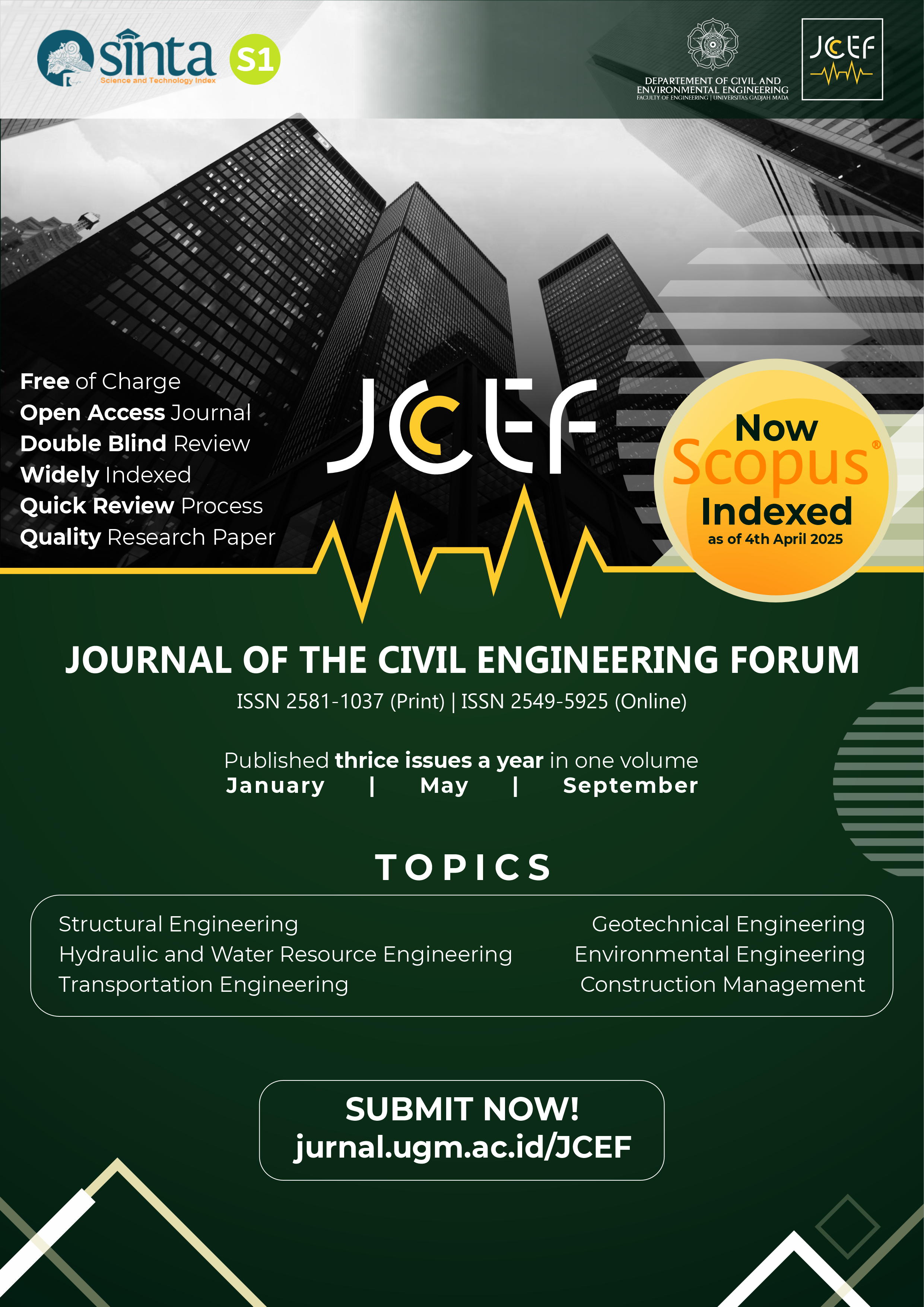Comparison of Material Point Method and Finite Element Method for Post-Failure Large Deformation Geotechnical Analysis
Abstract
Finite Element Method (FEM) has been the state-of-the-art method in geotechnical analysis since it first formulated in the 40s. It capable to handle Multiphysics simulation, soil-structure and soil-water interaction, and time history analysis. Though powerful, the standard Lagrangian FEM suffers mesh distortion when handling large strain deformation problem. This mesh entanglement problem makes post-failure analysis is considerably challenging to model if not impossible to do using FEM. The Material Point Method (MPM) then later introduced to solve these large strain deformation problems. Adapted from the Particle in Cell (PIC) method, MPM is a hybrid method that combines Eularian and Lagrangian approach by utilizing moving material points which are moving over spatially fixed computational mesh. This approach enables MPM to calculate not only fluid mechanics such in PIC but also solid mechanics and its intermediatory states. To demonstrate the capability of MPM and its consistency with FEM in geotechnical analysis, this article presents a comparison of FEM and MPM analysis on a hypothetical slope using Mohr-Coulomb constitutive model. The simulation shows that both FEM and MPM analyses are consistent to each other especially in small strain scheme. However, in large strain deformation, MPM is still able to get convergent result while FEM is not. The MPM simulation is also able to animate post failure behavior clearly, calculate post-failure strains and stresses distribution, and present final geometry of the model.
References
Al-kafaji, I. K. J. 2013. Formulation of a Dynamic Material Point Method (MPM) for Geomechanical Problems, PhD Thesis, Stuttgart: University Stuttgart. http://dx.doi.org/10.18419/opus-496
Bardenhagen, S. G. & Kober, E. M. 2004. The Generalized Interpolation Material Point Method. CMES-Computer Modeling in Engineering & Sciences 5: 477–496
De Béjar, L. A., & Danielson, K. T. 2016. Critical Time-Step Estimation for Explicit Integration of Dynamic Higher-Order Finite-Element Formulations. Journal of Engineering Mechanics 142. https://ascelibrary.org/doi/abs/10.1061/(ASCE)EM.1943-7889.0001082
Fern, E. J. & Soga, K. 2016. The role of constitutive models in MPM simulations of granular column collapses. Acta Geotechnica
Hamad, F., Giridharan, S., & Moormann, C. 2017. A Penalty Function Method for Modelling Frictional Contact in MPM. Procedia Engineering 175: 116–123. https://doi.org/10.1016/j.proeng.2017.01.038.
Harlow, F. H. 1964. The particle-in-cell computing method for fluid dynamics. Comput. Methods Physics 3: 319-343. https://cir.nii.ac.jp/crid/1572261550192093568
Kumar, K., Salmond, J., Kularathna, S., Wilkes, C., Tjung, E., Biscontin, G., & Soga, K. 2019. Scalable and modular material point method for large scale simulations. 2nd International Conference on the Material Point Method.
Lucy, L. B., 1977. A numerical approach to the testing of the fission hypothesis. Astronomical Journal 82: 1013 – 1024. https://doi.org/10.48550/arXiv.1909.13380
Pastor, M., Haddad, B., Sorbino, G., Cuomo, S. & Drempetic, V. 2009. A depth-integrated, coupled SPH model for flow-like landslides and related phenomena. International Journal for Numerical and Analytical methods in Geomechanics 33: 143-172. https://doi.org/10.1002/nag.705
Pastor, M., Blanc, T., Haddad, B., Petrone, S., Sanchez Morles, M., Drempetic, V., Issler, D., Crosta, G. B., Cascini, L., Sorbino, G. & Cuomo, S. 2014. Application of a SPH depth-integrated model to landslide run-out analysis. Landslides: 793-812
PLAXIS. 2021. Scientific Manual. Delft University of Technology & PLAXIS. Netherland: A. A. Balkema
Qiu, G., Henke, S., & Grabe, J. 2010. A Coupled Eulerian-Lagrangian approach to solve geotechnical problems involving large deformations. Numerical Methods in Geotechnical Engineering (NUMGE): 233-238
Sadeghirad, A., Brannon, R. M., & Burghardt, J., 2011. A convected particle domain interpolation technique to extend applicability of the material point method for problems involving massive deformation. International Journal for Numerical Methods in Engineering 86: 1435-1456. https://doi.org/10.1002/nme.3110
Sulsky, D., Chen, Z. & Schreyer, H. 1994. A particle method for history-dependent materials. Comput. Methods Appl. Mech. Engineering 118: 179 – 196. https://doi.org/10.1016/0045-7825(94)90112-0
Vaucorbeil, A., Nguyen, V. P., Sinaie, S. & Wu, J. Y. 2020. Material point method after 25 years: Theory, implementation, and applications. Advances in Applied Mechanics 53: 186 - 398. https://doi.org/10.1016/bs.aams.2019.11.001
Zhou, X. & Sun, Z. 2020. Quantitative assessment of landslide risk using Monte Carlo material point method. Engineering Computations 37: 1577-1596. https://ascelibrary.org/doi/abs/10.1061/(ASCE)EM.1943-7889.0001082
Copyright (c) 2023 The Author(s)

This work is licensed under a Creative Commons Attribution-ShareAlike 4.0 International License.
Copyright is granted to authors for the purpose of providing protection for articles written to describe experiments and their results. JCEF will protect and defend the work and reputation of the author and are also willing to address any allegations of violation, plagiarism, fraud, etc. against articles written and published by JCEF. JCEF is published under the terms of the Creative Commons Attribution-ShareAlike 4.0 International License (CC BY-SA 4.0). The author holds the copyright and assigns the journal rights to the first publication (online and print) of the work simultaneously.






